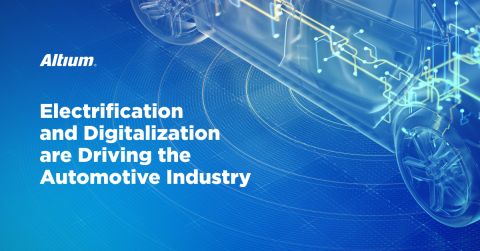The Last Mile of Digital Transformation Made Easy

We live in an era fueled by innovation. In almost every aspect of our lives, we are constantly being reminded about the pace of innovation, its relentless acceleration touted in the news, its benefit on our lives, and the lifestyles our gadgets enable. For those of us whose business is electronic product design, the impacts of rapid innovation, changing market conditions, and customer expectations also permeate every aspect of our working environment.
Across every industry, relentless innovation and new complexities are bringing fundamental changes to the way businesses run and how products are designed and manufactured. Companies must adapt and transform at virtually every level to keep up with these changes. It is becoming clear to both veteran and startup companies alike that many long-standing business practices, product development processes, and product support policies can't keep up in today's rapidly changing product development environment.
To stay competitive and adapt, electronic product companies are embracing digital transformation by adopting strategic initiatives, connecting once-disjointed people, processes, and applications across the entire enterprise organization.
We are seeing successful digital initiatives that manage the overall business with MRP/ERP and sales platforms, along with digital engineering that integrates product development and life-cycle management solutions spanning product ideation, development, and design, through to support and even sustainable disposal.
“Digital transformation is absolutely important to our customers’ electronics business strategy and competitiveness.”
Don Cantow, Senior Vice President Altium Enterprise Solutions
Altium customers are embracing transformation. Don Cantow, Senior Vice President of Enterprise Solutions at Altium, points to digital transformation as key to many customers’ strategy to evolve their business and innovate to stay competitive. He explains that for product engineering, particularly the electronics aspect, "digital transformation is like the digital thread that ties everything together. The source content has an origin that is continuous throughout and digitally connected."
Digital transformation initiatives for many companies enable businesses to transform their product development organizations by connecting people and processes while integrating various applications across departments and design domains to make them more efficient. Don added, "All aspects of customer’s operations, engineering, and supply chain connect into that digital thread and leverage the same source of truth." Improving collaboration and enabling access and visibility to product data is helping companies gain a competitive edge and provide enhanced customer experiences.
Digital Integration and Continuity Across the Enterprise
As companies work towards digital transformation, the initial focus tends to be on integrating business and enterprise management organizations. However, it is also important to connect engineering and product development systems in order to take advantage of the latest digital processes and advance product innovation.
For transformation in the engineering domains, digital integration and digital continuity are the keys to success. Digital integration helps optimize engineering practices, tools, and environments by integrating design applications to combine or enhance data exchanges and workflows within or across the product design domains. Digital continuity gives engineers access and visibility to the same or relevant versions of cross-domain design data and information to stay synchronized, improve collaboration, and optimize decision-making. Both digital integration and continuity help break down disjointed design and information silos, improving efficiency and productivity.
Underpinning product and data digitization is Product Lifecycle Management (PLM). In the engineering domain, PLM is one of the foundation sources for design and product data and information. PLM has evolved over the years, from simple file management in the early days of computer-aided engineering (CAE) and computer-aided design (CAD), to today, where PLM is key to transformation across enterprise and engineering organizations supporting a variety of product development and supply chain strategies.
PLM has established itself as the framework for digital transformation. According to the Aberdeen Group, “In the face of rising complexity, integrated PLM has become the innovation platform for digital transformation. 61% of Best-in-Class firms have had a PLM solution in place for three or more years [and] 40% of Best-in-Class manufacturers identify PLM as the primary application for release management.”
Electronics Design Digital Transformation
From an engineering perspective, software and mechanical design teams have long utilized product and data management strategies to integrate workflows and processes more effectively, while also addressing development challenges such as collaboration, disconnected processes, engineering changes, product complexity, and data quality and integrity.
Yet, while enterprise organizations are investing significantly in digital transformation,. Even within the electronic development process itself, people, workflows, and applications are historically siloed and only loosely linked together. Scott Morris, a senior manager at iRobot described the disconnect this way, “When ECAD is a silo and PLM is the source of truth for the product record, but all you have is the placeholder number in PLM, you don’t know what’s in it. How do we manufacture it? Without a complete digital definition, it becomes harder to describe the full product.”
“Without a complete digital definition, it becomes harder to describe the full product.”
Scott Morris, Senior Manager, iRobot
Like their counterparts from other engineering domains, electronic design teams have business and development challenges to improve product quality, meet development timelines and schedules, and reduce costs. Teams that continue to work the "old way" using manual workflows, over-the-wall collaboration, and ad-hoc design/data management methodologies run the risk of missed schedules, increased development costs, and reduced product quality. Companies and engineering departments can no longer afford to overlook the digital transformation of the ECAD domain.
Extending digital transformation and integration throughout electronics design creates a digital workplace that integrates design applications, workflows, and production activities. When electronics design is integrated into the overall product design process, team members from all the design domains are free to collaborate across every element of the product, using the same data models, design documents, component information, and more.
Companies with fully integrated digital processes are empowered with seamless collaboration and real-time information informing every step of product development.
- Stakeholder feedback can be easily requested and reviewed at every stage of the design
- Changes can quickly be implemented, tracked, and executed
- Centralized design libraries can be securely stored and easily accessed
- Supply chain availability data can be accessed during component selection
- ECAD-MCAD design collaboration and file exchanges become seamless
- Managed workflows are more efficient overall, allowing predictability and repeatability
Digitally integrating and transforming electronics engineering is often the "last mile" of the digital transformation journey.
Altium Enterprise Solutions: The Last Mile of Digital Transformation Made Easy
Engineering and product-centric lifecycle management systems (PLM) help connect design, quality, and product development processes. What's more, PLM can represent a single source of truth to help comply with regulatory compliance needs and streamline product development.
A digitally integrated electronics engineering solution links a product-centric PLM directly into design and engineering applications. In addition, all engineering and design applications are integrated with one another, creating a fully digitally-connected electronics design workplace. Extending the digital thread within and across the multiple product design domains provides continuity of the design data for the broader product development process.
The Altium enterprise solutions provide comprehensive, digitally-integrated, electronics and PCB design capabilities. They enable enterprise organizations of all sizes to leverage their best-in-class technologies, development processes, and people allowing them to fundamentally transform their electronics design environment.
By digitally-connecting electronics design to existing technology investments – including PLM, MCAD, and simulation – Altium enterprise solutions allow companies to seamlessly integrate their product development teams and processes from concept to realization. In addition, digitally-managed process workflows, along with connected resources, enable intuitive and valuable collaboration across domains and disciplines.
- Digitally Connect ECAD to the Enterprise
Integrating schematic and PCB layout into a digitally-connected, managed, electronic product development environment enables seamless integration with existing technology and design investments across the enterprise. Once ECAD becomes part of the enterprise digital workflow, all team members gain on-demand access and visibility to design information in both the earliest stages of development – when potential problems are easier to address – and throughout the entire product design process. Learn more about digitally-integrating Schematic Design and PCB Layout
- Cross-domain and Cross-discipline Collaboration
Digitally-connected electrical engineers and PCB designers can easily collaborate in a managed way with adjacent domains – including mechanical, procurement, and manufacturing – decreasing miscommunication and common errors associated with manual processes that affect siloed teams today. Designers and stakeholders – including product management, supply chain vendors, and manufacturers – also gain transparency to electronic design work in progress as well as easy access to real-time component and supply chain data. People in each domain can continue to work in the way they typically work without having to become experts in another domain or disrupting other people’s workflows. Learn more about truly digitally-integrated ECAD-MCAD collaboration
- Digitally-Managed Workflows, Process, and Resources
Workflow automation is essential for any enterprise organization looking to streamline their processes and improve efficiency. By digitizing and capturing best practices and regulatory requirements in automated workflows, organizations can develop repeatable, predictable processes and significantly reduce human error. Automated workflow management also provides a complete history, along with automated task management and automated notifications, making it easy to track project progress on demand without the need for manual status updates. Learn more about workflow management
The digital continuity that the Altium enterprise solutions provide enables project challenges to be addressed and decisions to be made at the critical points of impact – when they matter most.
The Altium enterprise solutions are the most lightweight, easy-to-implement electronics design solutions for enterprise organizations of all sizes or maturity, making the last mile of digital transformation not only possible – but easy.
Built on the same powerful, customer-centric PCB design foundation of Altium Designer® – the world’s most popular PCB design software – Altium is transforming electronics design.




